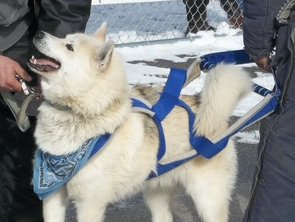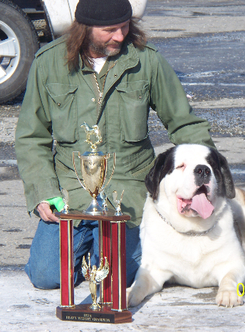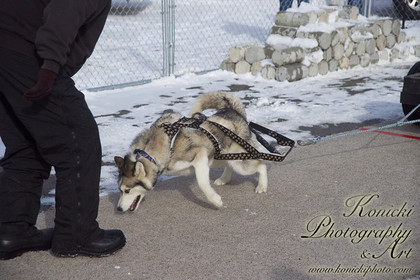About
Interior Freight Dog
Association
Interior Freight Dog
Association
Ever wonder just how strong your dog really is?
This is the way to find out. Come out and pull with some of the strongest dogs in the Interior and watch their epic feats!
The winter months we use a 200 pound sled and during the no-snow days we use a cart weighing in at 320 pounds. The dogs have 60 seconds to pull the cart/sled 25 feet. We will then add weights in 120 pound increments until they can out pull their competitors in the same weight class.
Competitors (dogs) must weigh at least 25 pounds and be between 1-10 years of age. There are 4 weight categories: 25-60 pounds (ultralights), 60-90 pounds ( light weight), 90-125 pounds (middle weights), and 125 and over (heavy weights).
All dogs must have current vaccinations.
Loaner harnesses are available at the practices and the competitions.
We encourage handlers of all ages to come on out!
This is the way to find out. Come out and pull with some of the strongest dogs in the Interior and watch their epic feats!
The winter months we use a 200 pound sled and during the no-snow days we use a cart weighing in at 320 pounds. The dogs have 60 seconds to pull the cart/sled 25 feet. We will then add weights in 120 pound increments until they can out pull their competitors in the same weight class.
Competitors (dogs) must weigh at least 25 pounds and be between 1-10 years of age. There are 4 weight categories: 25-60 pounds (ultralights), 60-90 pounds ( light weight), 90-125 pounds (middle weights), and 125 and over (heavy weights).
All dogs must have current vaccinations.
Loaner harnesses are available at the practices and the competitions.
We encourage handlers of all ages to come on out!
Training should be and is easy and fun, and outside the necessary harness almost free! A properly fitted weight pulling harness is necessary. It keeps the dog from getting hurt and allows him to pull the maximum weight he can. The correct harness will have a bar behind the back legs of the dog.
Most harnesses are fitted to the individual dog; because the time the maker spends measuring a dog and making the harness, they aren't free. On the other hand, they don't cost hundreds of dollars either.
It's a good idea if your dog already has some basic obedience training. One of the things that happens when your dog starts training and doing weight pulls is that he becomes very strong; and if he's headstrong, you might have a bit of a problem convincing him that you want him to heel when your walking together.
If you have a rookie dog, get him used to the harness over the course of a few nights, spending a total of about 15 minutes per session. It takes longer than that to train some dogs to sit on command! You can just incorporate the harness into your regular playtime. Let him sniff it, lick, sit on it, virtually anything other than chewing it or wetting on it, until he basically ignores it.
Putting the harness on should be playtime at first. Scratch him with it and play a bit while putting it on and he probably won't even notice. If your dog balks, don't force the issue; back off and try again later.
Now, you need something for the dog to pull. It can be anything from an old tire or pallet, to a piece of wood. Find an old piece of rope and an old clip from a broken leash. Start light, some dogs spook over just a twig but don't give up, and over the week you can gradually add weight as your dog tolerates. If he wont pull, don't give up. Help him through it by pulling on the top of the harness and "help" him. Eventually he will pulling like there is nothing there.
Just remember that this needs to be fun for him and it will be fun for you too.
Most harnesses are fitted to the individual dog; because the time the maker spends measuring a dog and making the harness, they aren't free. On the other hand, they don't cost hundreds of dollars either.
It's a good idea if your dog already has some basic obedience training. One of the things that happens when your dog starts training and doing weight pulls is that he becomes very strong; and if he's headstrong, you might have a bit of a problem convincing him that you want him to heel when your walking together.
If you have a rookie dog, get him used to the harness over the course of a few nights, spending a total of about 15 minutes per session. It takes longer than that to train some dogs to sit on command! You can just incorporate the harness into your regular playtime. Let him sniff it, lick, sit on it, virtually anything other than chewing it or wetting on it, until he basically ignores it.
Putting the harness on should be playtime at first. Scratch him with it and play a bit while putting it on and he probably won't even notice. If your dog balks, don't force the issue; back off and try again later.
Now, you need something for the dog to pull. It can be anything from an old tire or pallet, to a piece of wood. Find an old piece of rope and an old clip from a broken leash. Start light, some dogs spook over just a twig but don't give up, and over the week you can gradually add weight as your dog tolerates. If he wont pull, don't give up. Help him through it by pulling on the top of the harness and "help" him. Eventually he will pulling like there is nothing there.
Just remember that this needs to be fun for him and it will be fun for you too.

Tips for training



Double click here to edit this text.
Rules
.GENERAL RULES:
1. All entrants are responsible for the conduct of their dogs. Each dog must be under the control of its owner/handler and on a leash attached to a collar at all times. Barking should be minimized. Any aggressive behavior/fighting is not permitted. Any unruly dogs will be disqualified.
2. Non participating dogs are not allowed at the pull competitions/events.
3. All dogs must be current on vaccinations with proof required at time of sign up or first practice pull.
4. Any dog showing any signs of illness will not be allowed to pull. Said dog will be asked to leave competition area.
5. Minimum weight is 25 pounds with minimum age of any dog pulling is 1 year, maximum age is 10 years.
6. Females in season will not be allowed to compete for safety reasons.
7. The cruel and inhumane treatment of any dog by any handler/owner on the track or within the vicinity of the weight pull is strictly prohibited under penalty of disqualification. The track Marshall, club officers, or other track official will have the discretion of what constitutes inhumane treatment.
8. The weight pull coordinator or his/her committee may reject any entry.
9. The decision by the officials will be final in all cases. Any challenges to final decisions must be submitted to the weight pull coordinator in writing. A response will be made in writing to the challenge.
10. If an official is also a handler or a family member of a handler in a dispute, the official must turn over to an alternate official to decide outcome of dispute.
11. Handlers/owners are responsible for the cleanup of all messes and garbage made by themselves or their dogs.
WEIGHT PULLING EVENT:
1. Sled use, weights used, and track conditions will be determined by the event officials and Association.
2. To complete a pull the dog must pull the weighted sled 16 feet in not more than 60 seconds. If the sled is moving at the 60 second mark the pull will be considered complete if the dog continues to pull over the finish line without stopping. At which time the official pull time will be recorded.
3. Time will start when the handler calls the dog or the dog moves on their own. Time is stopped when the front of the sled crosses the finish line.
4. The handler may designate the location of the sled along the starting line in relation to the ice pad
5. If the handler asks for the sled to be broken, the pull must not begin until the sled has come to a complete stop. Any dog that begins to pull while the sled is being broken will be disqualified.
6. Once time begins the handler is NOT to touch the dog or equipment EXCEPT if a dog becomes tangled. The handler must indicate to the track official that he wishes to clear the tangle before touching the dog. Time will continue to run in this situation.
7. If the tow line, or harness breaks the dog will be allowed to pull at the same weight with a new start time of 60 seconds.
8. The will dog must pull within the marked chute area. If the dog pulls the sled into a barrier the dog must unlodge the sled under his own power. Time will continue to run.
9. Leashes/leads are to be removed prior to start of pull. Short leads that will not hinder the dog in anyway may be attached to the collar.
10. No encouragement is to be given to a dog while in a pull by anyone other than the handler. This includes any assistance in the warm up area.
11. Dogs will not be encouraged to pull by the use of food, bait, or toys. Only voice or hand commands are permitted. Dogs may be worked from front or side. The handler must not go past the front of the sled/cart.
12. Once a weight class begins all participants for that class must report to the warm up areas. This will keep the event running in a timely manner for all. If and when a called participant is not available in the warm up area that person will be at risk of missing their call to pull
13. When called, the handler may call out “pass” to skip their turn, otherwise the handler must pull in order of draw.
14. Any dog eliminated by not completing a pull must leave the warm up area.
15. The starting weight and weight increments will be determined by the track conditions and the Association.
16. In the case of a tie the winner will be determined by the least time used to complete a pull. Tie breakers will be determined by least time used in the previous pull if necessary.
17. The track and/or ice pad cannot be cleaned/groomed until all dogs of a given weight class have completed their weight increments.
18. Any person associated with a participant, and/or the handler/owner is responsible for proper conduct of any and all people and animals at an event. Any unsportsmanlike conduct will be grounds for disqualification from the event. Unsportsmanlike conduct can include, but will not be limited to arguing with any official or participant in the contest. This disqualification will be at the discretion of the track marshal or Association and the decision will be final. Continuation of this conduct will be cause for dismissal for the reminder of the season.
1. All entrants are responsible for the conduct of their dogs. Each dog must be under the control of its owner/handler and on a leash attached to a collar at all times. Barking should be minimized. Any aggressive behavior/fighting is not permitted. Any unruly dogs will be disqualified.
2. Non participating dogs are not allowed at the pull competitions/events.
3. All dogs must be current on vaccinations with proof required at time of sign up or first practice pull.
4. Any dog showing any signs of illness will not be allowed to pull. Said dog will be asked to leave competition area.
5. Minimum weight is 25 pounds with minimum age of any dog pulling is 1 year, maximum age is 10 years.
6. Females in season will not be allowed to compete for safety reasons.
7. The cruel and inhumane treatment of any dog by any handler/owner on the track or within the vicinity of the weight pull is strictly prohibited under penalty of disqualification. The track Marshall, club officers, or other track official will have the discretion of what constitutes inhumane treatment.
8. The weight pull coordinator or his/her committee may reject any entry.
9. The decision by the officials will be final in all cases. Any challenges to final decisions must be submitted to the weight pull coordinator in writing. A response will be made in writing to the challenge.
10. If an official is also a handler or a family member of a handler in a dispute, the official must turn over to an alternate official to decide outcome of dispute.
11. Handlers/owners are responsible for the cleanup of all messes and garbage made by themselves or their dogs.
WEIGHT PULLING EVENT:
1. Sled use, weights used, and track conditions will be determined by the event officials and Association.
2. To complete a pull the dog must pull the weighted sled 16 feet in not more than 60 seconds. If the sled is moving at the 60 second mark the pull will be considered complete if the dog continues to pull over the finish line without stopping. At which time the official pull time will be recorded.
3. Time will start when the handler calls the dog or the dog moves on their own. Time is stopped when the front of the sled crosses the finish line.
4. The handler may designate the location of the sled along the starting line in relation to the ice pad
5. If the handler asks for the sled to be broken, the pull must not begin until the sled has come to a complete stop. Any dog that begins to pull while the sled is being broken will be disqualified.
6. Once time begins the handler is NOT to touch the dog or equipment EXCEPT if a dog becomes tangled. The handler must indicate to the track official that he wishes to clear the tangle before touching the dog. Time will continue to run in this situation.
7. If the tow line, or harness breaks the dog will be allowed to pull at the same weight with a new start time of 60 seconds.
8. The will dog must pull within the marked chute area. If the dog pulls the sled into a barrier the dog must unlodge the sled under his own power. Time will continue to run.
9. Leashes/leads are to be removed prior to start of pull. Short leads that will not hinder the dog in anyway may be attached to the collar.
10. No encouragement is to be given to a dog while in a pull by anyone other than the handler. This includes any assistance in the warm up area.
11. Dogs will not be encouraged to pull by the use of food, bait, or toys. Only voice or hand commands are permitted. Dogs may be worked from front or side. The handler must not go past the front of the sled/cart.
12. Once a weight class begins all participants for that class must report to the warm up areas. This will keep the event running in a timely manner for all. If and when a called participant is not available in the warm up area that person will be at risk of missing their call to pull
13. When called, the handler may call out “pass” to skip their turn, otherwise the handler must pull in order of draw.
14. Any dog eliminated by not completing a pull must leave the warm up area.
15. The starting weight and weight increments will be determined by the track conditions and the Association.
16. In the case of a tie the winner will be determined by the least time used to complete a pull. Tie breakers will be determined by least time used in the previous pull if necessary.
17. The track and/or ice pad cannot be cleaned/groomed until all dogs of a given weight class have completed their weight increments.
18. Any person associated with a participant, and/or the handler/owner is responsible for proper conduct of any and all people and animals at an event. Any unsportsmanlike conduct will be grounds for disqualification from the event. Unsportsmanlike conduct can include, but will not be limited to arguing with any official or participant in the contest. This disqualification will be at the discretion of the track marshal or Association and the decision will be final. Continuation of this conduct will be cause for dismissal for the reminder of the season.